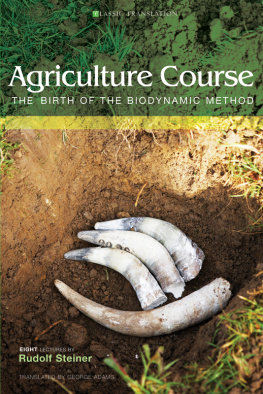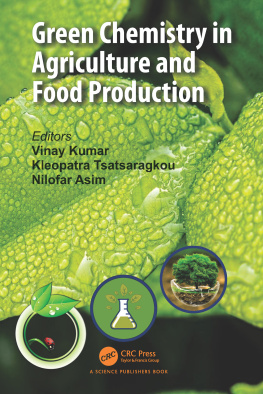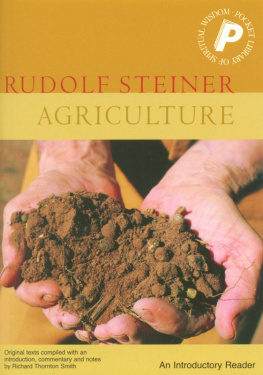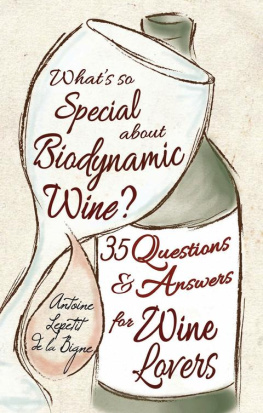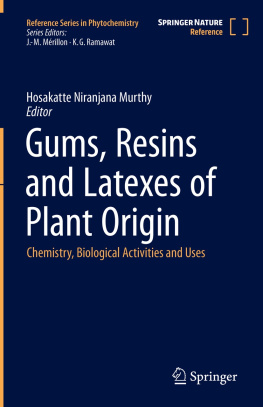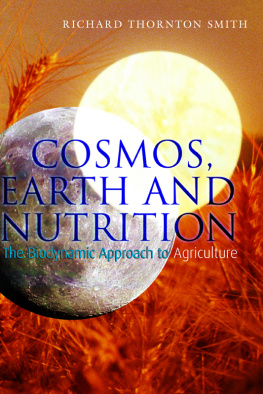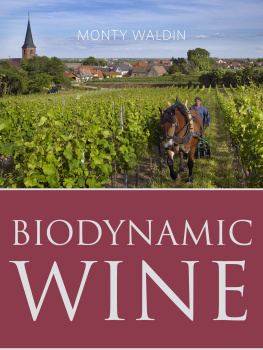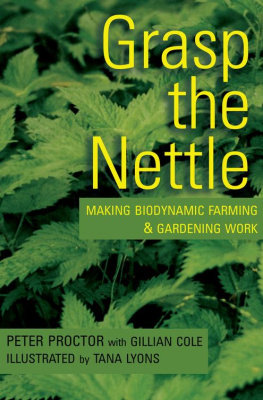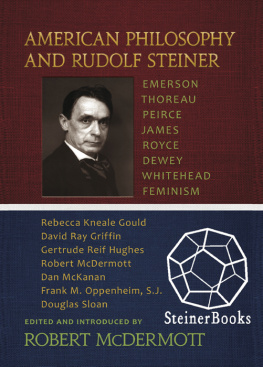AGRICULTURE COURSE
The Birth of the Biodynamic Method
Eight lectures given in Koberwitz, Silesia, between
7 and 16 June 1924
RUDOLF STEINER
RUDOLF STEINER PRESS
Translated by George Adams
Rudolf Steiner Press
Hillside House,
The Square Forest Row,
E. Sussex RH18 5ES
www.rudolfsteinerpress.com
Published by Rudolf Steiner Press 2012
First published in English in 1958
Originally published in German under the title Geisteswissenschaftliche Grundlagen zum Gedeihen der Landwirtschaft (volume 327 in the Rudolf Steiner Gesamtausgabe or Collected Works) by Rudolf Steiner Verlag, Dornach. This translation is published by permission of the Rudolf Steiner Nachlassverwaltung, Dornach
Translation Rudolf Steiner Press 1958
All rights reserved. No part of this publication may be reproduced, stored in a retrieval system, or transmitted, in any form or by any means, electronic, mechanical, photocopying or otherwise, without the prior permission of the publishers
A catalogue record for this book is available from the British Library
ISBN 978 1 85584 353 0
Cover by Andrew Morgan Design
CONTENTS
PREFACE
BY
EHRENFRIED PFEIFFER, M.D.(H ON .)
In 1922/23 Ernst Stegemann and a group of other farmers went to ask Rudolf Steiners advice about the increasing degeneration they had noticed in seed-strains and in many cultivated plants. What can be done to check this decline and to improve the quality of seed and nutrition? That was their question.
They brought to his attention such salient facts as the following: Crops of lucerne used commonly to be grown in the same field for as many as thirty years on end. The thirty years dwindled to nine, then to seven. Then the day came when it was considered quite an achievement to keep this crop growing in the same spot for even four or five years. Farmers used to be able to seed new crops year after year from their own rye, wheat, oats and barley. Now they were finding that they had to resort to new strains of seed every few years. New strains were being produced in bewildering profusion, only to disappear from the scene again in short order.
A second group went to Dr. Steiner in concern at the increase in animal diseases, with problems of sterility and the widespread foot-and-mouth disease high on the list. Among those in this group were the veterinarian Dr. Joseph Werr, the physician Dr. Eugen Kolisko, and members of the staff of the newly established Weleda, the pharmaceutical manufacturing enterprise.
Count Carl von Keyserlingk brought problems from still another quarter. Then Dr. Wachsmuth and the present writer went to Dr. Steiner with questions dealing particularly with the etheric nature of plants, and with formative forces in general. In reply to a question about plant diseases, Dr. Steiner told the writer that plants themselves could never be diseased in a primary sense, since they are the products of a healthy etheric world. They suffer rather from diseased conditions in their environment, especially in the soil; the causes of so-called plant diseases should be sought there. Ernst Stegemann was given special indications as to the point of view from which a farmer could approach his task, and was shown some first steps in the breeding of new plant types as a first impetus towards the subsequent establishment of the biological-dynamic movement.
In 1923 Rudolf Steiner described for the first time how to make the bio-dynamic compost preparations, simply giving the recipe without any sort of explanationjust do this and then that. Dr. Wachsmuth and I then proceeded to make the first batch of preparation 500. This was then buried in the garden of the Sonnenhof in Arlesheim, Switzerland. The momentous day came in the early summer of 1924 when this first lot of 500 was dug up again in the presence of Dr. Steiner, Dr. Wegman, Dr. Wachsmuth, a few other co-workers and myself. It was a sunny afternoon. We began digging at the spot where memory, aided by a few landmarks, prompted us to search. We dug on and on. The reader will understand that a good deal more sweating was done over the waste of Dr. Steiners time than over the strenuousness of the labour. Finally he became impatient and turned to leave for a five oclock appointment at his studio. The spade grated on the first cowhorn in the very nick of time.
Dr. Steiner turned back, called for a pail of water, and proceeded to show us how to apportion the horns contents to the water, and the correct way of stirring it. As the authors walking stick was the only stirring implement at hand, it was pressed into service. Rudolf Steiner was particularly concerned with demonstrating the energetic stirring, the forming of a funnel or crater, and the rapid changing of direction to make a whirlpool. Nothing was said about the possibility of stirring with the hand or with a birch-whisk. Brief directions followed as to how the preparation was to be sprayed when the stirring was finished. Dr. Steiner then indicated with a motion of his hand over the garden how large an area the available spray would cover. Such was the momentous occasion marking the birth-hour of a worldwide agricultural movement.
What impressed me at the time, and still gives one much to think about, was how these step-by-step developments illustrate Dr. Steiners practical way of working. He never proceeded from preconceived abstract dogma, but always dealt with the concrete given facts of the situation. There was such germinal potency in his indications that a few sentences or a short paragraph often sufficed to create the foundation for a farmers or scientists whole life-work; the agricultural course is full of such instances. A study of his indications can therefore scarcely be thorough enough. One does not have to try to puzzle them out, but can simply follow them to the letter.
Dr. Steiner once said, with an understanding smile, in another, very grave situation, that there were two types of people engaged in anthroposophical work: the older ones, who understood everything, but did nothing with it, and the younger ones, who understood only partially or not at all, but immediately put suggestions into practice. We obviously trod the younger path in the agricultural movement, which did all its learning in the hard school of experience. Only now does the total picture of the new impulse given by Rudolf Steiner to agriculture stand clearly before us, even though we still have far to go to exhaust all its possibilities. Accomplishments to date are merely the first step. Every day brings new experience and opens new perspectives.
* * *
Shortly before 1924, Count Keyserlingk set to work in dead earnest to persuade Dr. Steiner to give an agricultural course. As Dr. Steiner was already overwhelmed with work, tours and lectures, he put off his decision from week to week. The undaunted Count then dispatched his nephew to Dornach, with orders to camp on Dr. Steiners doorstep and refuse to leave without a definite commitment for the course. This was finally given.
The agricultural course was held from June 7 to 16, 1924, in the hospitable home of Count and Countess Keyserlingk at Koberwitz, near Breslau. It was followed by further consultations and lectures in Breslau, among them the famous Address to Youth. I myself had to forgo attendance at the course, as Dr. Steiner had asked me to stay at home to help take care of someone who was seriously ill. Ill write and tell you what goes on at the course, Dr. Steiner said by way of solace. He never did get round to writing, no doubt because of the heavy demands on him; this was understood and regretfully accepted. On his return to Dornach, however, there was an opportunity for discussing the general situation. When I asked him whether the new methods should be started on an experimental basis, he replied: The most important thing is to make the benefits of our agricultural preparations available to the largest possible areas over the entire earth, so that the earth may be healed and the nutritive quality of its produce improved in every respect. That should be our first objective. The experiments can come later. He obviously thought that the proposed methods should be applied at once.
Next page
